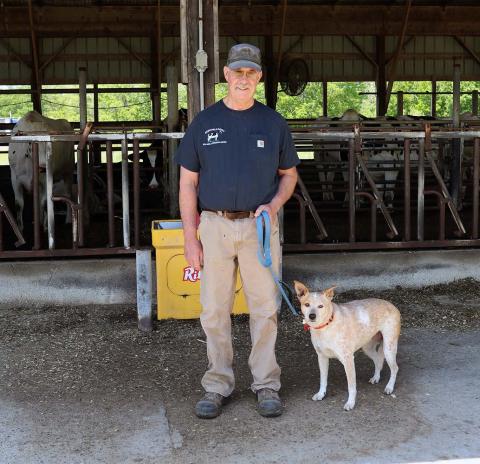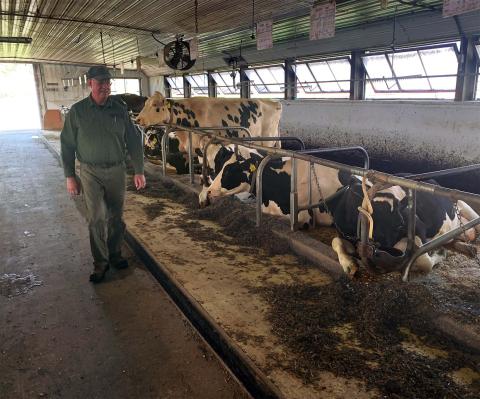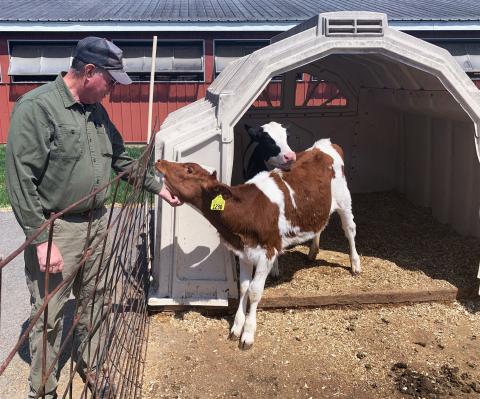
Fairchild Dairy Teaching and Research Center farm manager Jon Whitehouse marks his work anniversary with UNH roughly every graduation. That’s because one day after graduating from the University with a degree in Animal Science, Jon started his job as a farmhand at the former Ritzman dairy research center, originally located on Colovos Road behind Wildcat Stadium. From there, he became farm manager of Ritzman, then was tapped to serve as farm manager in 1989 of the newly opened, state-of-the-art Fairchild Dairy Teaching and Research Center, where he’s been ever since.
“We moved into Fairchild in December of 1989,” recalled Jon. “It took some time to get it ready for production, but we began operations the next year.”
In June 2023, Jon will mark his 39th year at UNH. Over close to four decades managing dairy farms at UNH, he’s seen plenty of changes—both in the programming offered at Fairchild and in the infrastructure, milking technology and herd composition at the dairy center.
Position: Farm Manager, Fairchild Dairy Teaching and Research Center
Years with NHAES: Since 1984
Previous positions: Earned his Bachelor’s degree in Animal Husbandry from UNH in 1984. One day after graduating, Whitehouse began working in the former Ritzman Farm off Colovos Road (now the site of the Jere A. Chase Ocean Engineering Laboratory). In 1989, he became farm manager of the newly opened Fairchild Dairy Teaching and Research Center, which he’s overseen since then.
Learn more
Jon Whitehouse: Fairchild combined the operations of two farms—the Ritzman research farm and the Old Dairy Barn, which now houses administrative houses adjacent to the UNH Equine Center. The Old Dairy Barn housed show cows, which appeared at The Big E and other state and regional fairs, so we stopped doing that when Fairchild opened.
The cows they put in the cream herd were primarily from the Old Dairy Barn, plus we had to buy in a bunch of new cows and adapt them to the new facility. Today, we have about 100 adult cows–both milking and dry (pregnant cows preparing to calve). At most, we had about 120 adult cows. And prior to the opening of the Organic Dairy Research Farm, we housed pregnant cows and heifers (cows that haven’t been pregnant yet) at that farm.
Staffing has changed over the years too. When Fairchild dairy opened, we had six staff members. That eventually went down to two full-time staff. Now we’re up to three full-time staff here.
How has the milking technology at Fairchild changed over the past 4 decades?
Jon: Yes, definitely. We’re on our fourth or fifth milking parlor—we’ve updated the equipment in there and revised the layout to accommodate new traffic patterns. We’ve changed dairy milking equipment brands a few times.
We’re up to speed now with an advanced program that essentially runs the parlor. From our computer, we can monitor milking production in real-time—we can see the numbers change and the length of milking time and a lot more. We’ve had this real-time monitoring system for about six years. We have automatic IDs now too—each cow has a transponder in her ear so we can monitor her production and health.


Jon Whitehouse has run the Fairchild Dairy Teaching and Research Center at UNH for close to four decades.
What spurred you to pursue this line of work? Did you grow up working on a farm?
Jon: Nope, not really. My father owned an eyeglass-repair business in Dover—it was originally started by my grandfather. We had 10 acres of land and he raised chickens, broilers, for a while. My brother and sister showed sheep, so we had a flock of Oxford sheep. So, I had some agricultural background, but nothing in dairy.
At first, I thought I was going to be a veterinarian. But I changed majors to focus more on dairy. I was in the Alpha Gamma Rho fraternity (agricultural fraternity) and got to know guys who had dairy farms through there. I became interested in the field and began working at the Ritzman dairy when I was an undergraduate.
What are some of those lessons you learned in the early days of running a dairy farm that you apply today?
Jon: When I moved into Fairchild, I was boss of these older farmhands who had a lot of cow knowledge. When I started off, I would always refer to my textbook knowledge — “Well the book says this…”. They taught me that you can’t always go by the book; that you need to be flexible; and that the wisdom gained from experience, and not just textbooks, is important. They had a little bit of a show background, so I learned a little about show cows from them too.
What is your role in working with researchers?
Jon: I serve as a liaison essentially, advising them on which cows would be best to use for their studies. For example, they may want cows that are all in a certain stage of lactation, so I’ll identify those types of things for them. I can pull all that information up on a computer to show them using our herd management software.
What advice would you offer to your future successor or any future managers of Fairchild Dairy Teaching and Research Center?
Jon: One thing I’d offer up is to encourage them to be patient. Everyone working here, they come from all different walks of life, so they need to understand that that includes people of all different experience in working with milking cows.